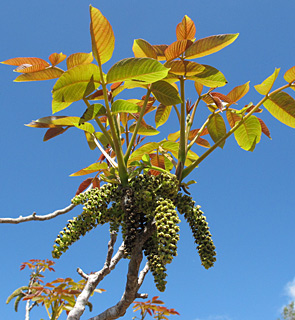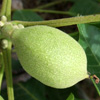Juglans regia (Common walnut, English walnut, Persian walnut, California walnut) is a large deciduous tree that serves as fruit and ornamental tree. It has a short trunk and a broad and high crown. The tree can reach a height of 35 m and a diameter of 2 m at breast height. These trees can reach an age of over 100. The tree originates from temperate savannahs at altitudes between 1000 and 2000 m, across almost all of Asia, from southwestern China through Nepal, Sri Lanka, Pakistan, Kirghizstan, Afghanistan, Türkmenistan, Azerbaijan, Iran, Armenia, Georgia, to eastern Turkey. Compared to the acclimated trees, the trees in their natural habitats exhibit a very broad genetic diversity, a lower height and nuts that grow along the branch and not at its tip. The huge natural almost solely common walnut forest in Kirghizstan, which spreads over 600 square km and is extensively cultivated, should be noted. Common walnut needs deep and well-drained soil, full sunlight and low winter temperatures.
The origin of the Latin name of the genus, Juglans, is Roman: Jovis glans, which means “god’s acorn or crown” and refers to that of Jupiter. The name of the species, regia, means “royal”. The name Persian walnut in English was given to the tree because it was brought from Persia to Greece and Europe in the wake of Alexander the Great’s conquests in the fourth century BCE.
The trunk is smooth and olive-brown in juvenile trees and turns gray and scabrous with deep grooves in the mature tree.
The leaves of common walnut are pinnate, reach a length of 25-40 cm, with 2-4 pairs of leaflets and a single leaflet at the tip. The more distant leaflets are larger and reach a length of 10-18 cm, and those near the base of the leaf are shorter and reach a length of 5-8 cm only.
Common walnut is a monoecious tree with unisexual flowers, i.e. each tree has separate male and female inflorescences. The male inflorescence is a cluster of catkins of flowers with no corolla, which is 5-10 cm long. The female flowers grow at the tip of the branch in clusters of 2-5 flowers that turn into a spherical drupe with a thin green shell that turns brown and later opens in four valves from which the familiar nut with the hard, light and coarse shell emerges.
The nuts are eaten raw or as ground nuts which are used for baking and cooking. It has great nutritional value of the walnut, because of its high content of mostly of unsaturated fatty acids and other substances that contribute to health, including 20-40% oleate, which is the substance that characterizes olive oil.
An infusion with great medicinal value in folk medicine can be prepared from the leaves, for treatment of various maladies such as worms, infections, skin diseases, etc. A drink for treating cough and dizziness is prepared from the male flowers. It was found that extracts from different parts of the tree have anti-cancer activity.
The wood of common walnut is hard and resistant and is used for making furniture. The bark of the trunk, the flowers and the fruit can be used to make yellowish-brownish dyes. The fruit’s oil can be used to polish furniture. The leaves contain insect-repellant substances and also have an inhibitory effect on the growth of other plants near the tree.
The genus Juglans includes 20 species, most of which grow on the American continent, from Canada to Argentina. Over 100 varieties have been domesticated, which exhibit resistance to cold, to limestone, to pests, etc. Trees in intensive plantations, especially in California, are composed of a scion from select trees on a stock of black walnut (Juglans nigra) or are grown from walnut seeds.
The global yield of walnuts reaches 850 thousand tons (data from 2006), with the leading producers being the United States (277 thousand), China (252 thousand), Iran (168 thousand) and Turkey (116 thousand).
The leaves and shells of the walnut contain germination-inhibiting substances and the shells are therefore used for the production of herbicides.
In Israel, where extensive irrigation is needed in the summer, walnuts grow in the Galilee and the Golan, mainly in irrigated boulevards at the entrances to settlements. A large and familiar tree was left from the settlement at Bek's Ruins on Mount Meron. The most conspicuous walnut trees in Israel are found in plantations on Mount Meron, where a variety which is suitable for limestone was selected, as well as near springs in the Judean Mountains, such as Ein Lavan and Sataf. The KKL (Jewish National Fund) planted orchards of walnuts from nuts in several places in its forests, including in the south, but these produce almost no fruits due to lack of water and/or doses of cold.
Written by Zvi Avni







